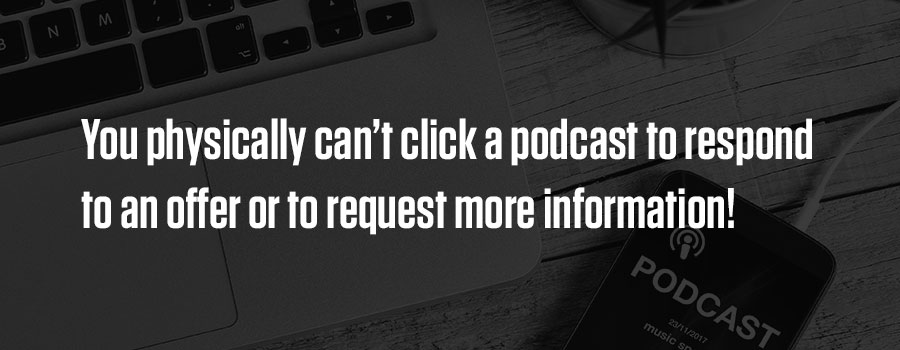
Marketing With Podcasts: The Challenges
“You should be marketing with podcasts because audio content is a hot trend,” say Internet marketing “experts” these days. I agree. Podcasts have the ability to connect with your target prospect base in a more personal and authentic way than through written words only.
But there are significant challenges to doing podcasts that need to be considered before leaping into the podcast pool.
What Exactly Is a Podcast?
While that may seem like a question with an obvious answer, I’d encourage you to understand exactly what a podcast is.
Though there have been podcasts that are music-based, most podcasts are spoken word presentations, delivered via electronic files, usually MP3s. Content can include a wide range of types including:
- News
- Interviews
- Opinions
- Education
- Entertainment
Podcasts can provide material that is either evergreen (meaning relevant for long periods of time) or time-sensitive (meaning its content could be relevant for mere days, or even hours).
What’s interesting is that the podcast, as we understand it today, didn’t really get going until 2003, a mere 15 years ago as of this post date. With the introduction of the iPod — which is why they’re called podcasts — shows and content could be delivered (broadcast) via iTunes to iPod devices. Then as smartphones and tablets began to include iPod-like features — especially after the introduction of the iPhone in 2007 — podcasts could be delivered via any mobile device via iTunes and several other podcast distribution networks.

The Podcast Learning Curve
So, podcasts are still a relatively new content medium. This is a good thing since they still provide opportunities in a less crowded field. But because it’s still a developing landscape, there’s also still a significant learning curve, especially for those using them for marketing purposes.
The technical issues include recording and editing audio files, choosing a hosting provider (hosting it yourself on your website can take some effort), and setting up distribution on podcast platforms such as iTunes, Stitcher and Google (which is setting up a podcast app in 2018).
With the introduction of the Amazon Alexa and similar voice assistant devices, another tech hurdle is to make sure a podcast can be listened to on them. As of this writing, on Alexa, a special Alexa Skill is needed (e.g., AnyPod, Stitcher).
But these tech challenges can pale in comparison to getting used to recording your voice and, even worse, getting used to hearing your recorded voice. While those who do live public speaking might have an easier time with this, even for them, getting used to speaking into the microphone in a lonely room can be unnerving.
What Should You Talk About on a Podcast?
This is another potential stumbling block. What will you talk about on the show, particularly if you’re doing a podcast to help promote your business? Listeners will quickly tune out if your presentation is nothing more than a sales pitch. It must provide valuable information. This has, of course, always been the case for content marketing, particularly with blogging.
Even if the podcast is a repurposing of existing blog material, realize that many posts may not morph well into becoming podcasts. I’ve found this to the be case for blog posts that contain quite a bit of technical material, or those that require visuals (images or videos) to effectively get a point across.
In general, there are two popular types of podcasts: Daily briefings and shows. Briefings are quick updates, often news or motivational/informational bits, delivered in a few minutes. Official shows are longer, usually running anywhere from five minutes up to an hour or more. The choice of program format will depend on the audience, type of content and budget.
Plus, you’ll need to decide how often you want to broadcast your show or briefing. If it’s daily, that could be a significant investment of time, energy and maybe money. Be conservative to start, then scale up as resources and positive results justify.
The Myth of Marketing With Podcasts
True, doing a podcast show can help establish yourself or your business as an expert and resource, and be a great addition to a content or inbound marketing program. However, the biggest problem is that marketing WITH podcasts requires marketing FOR the podcast!
Difficult to Index and Discover
Unlike text-based blog posts, podcasts are not always indexable by search engines, except for maybe the show’s or episode’s description, title and transcript (if posted). That may change in the future as search engines and functions become more adept at interpreting audio and voice data.
So, this means that your potential listeners are less likely to discover your show in searches. Plus, podcasts should be listed on several distribution networks to help increase discoverability, including iTunes, Stitcher, etc.
Bottom line: This means you’ll have to do some significant promotion to get people to even listen to the podcast, thereby upping the marketing investment or even making it inadvisable.
Podcasts Are Not Direct Response Marketing
While the hosting service used for the podcast can provide a wealth of listening analytics, the one thing it usually can’t deliver is data on clicks to your website. You physically can’t click a podcast to respond to an offer or to request more information! Sure, special links (e.g., landing pages) can be announced in the show to help monitor podcast responses. But you have to remember that many people will be listening to the show in their cars while driving, making even that action less likely.
What this means is podcasts, at this point in the medium’s evolution, are better suited for branding marketing purposes, not direct response. Set your expectations accordingly.
Author bio: Dr. Heidi Thorne, MBA/DBA, is the host of The Heidi Thorne Show podcast, which offers self-publishing news and insight. She is also a business blogger and the author of several books on publishing and marketing. To connect with Heidi, visit her website at HeidiThorne.com.




